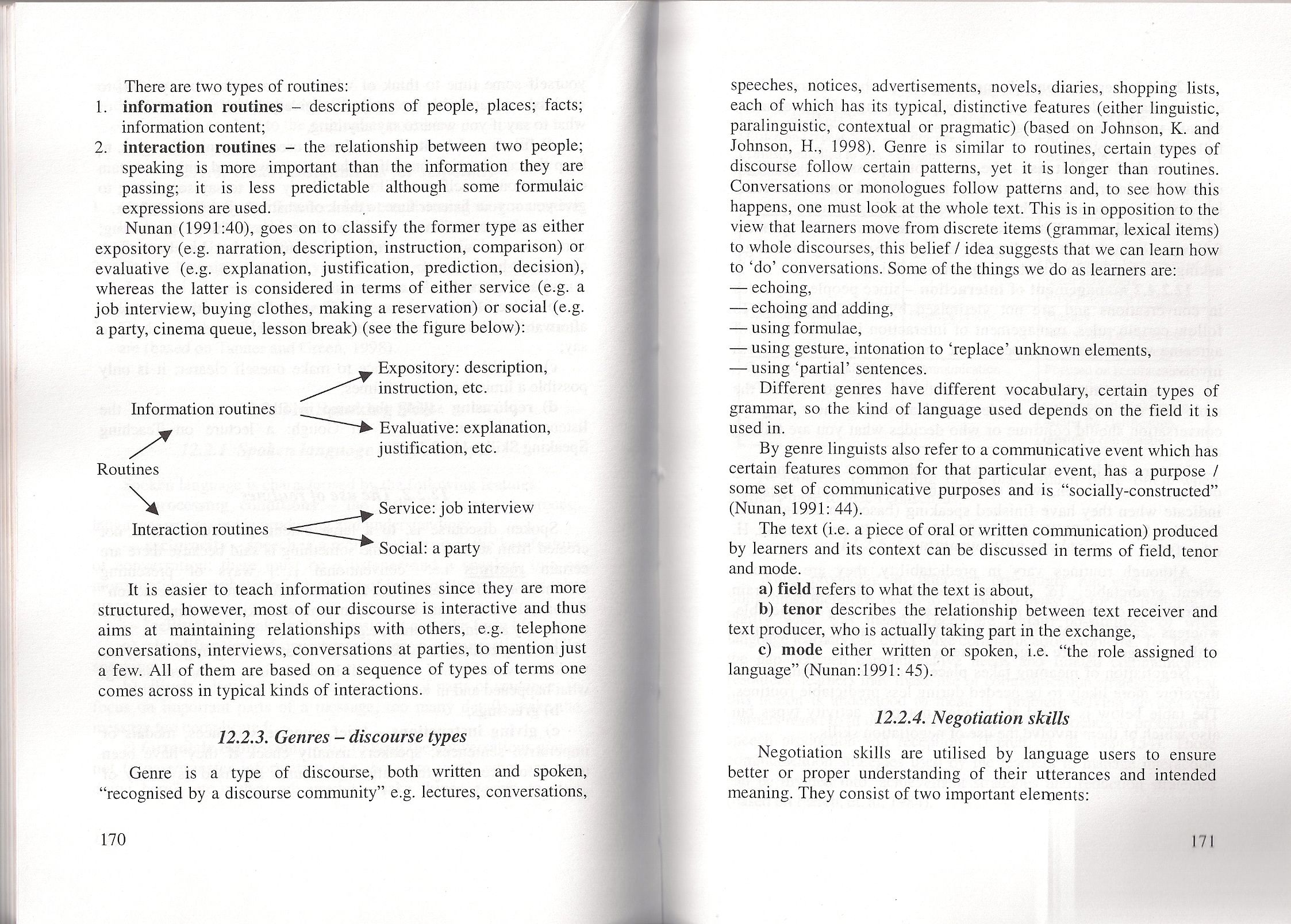62711 skanowanie0085 (2)

There are two types of routines:
1. information routines - descriptions of people, places; facts; information content;
|a interaction routines - the relationship between two people; speaking is morę important than the information they are passing; it is less predictable although some formulaic expressions are used.
Nunan (1991:40), goes on to classify the former type as either expository (e.g. narration, description, instruction, comparison) or evaluative (e.g. explanation, justification, prediction, decision), whereas the latter is considered in terms of either service (e.g. a job interview, buying clothes, making a reservation) or social (e.g. a party, cinema ąueue, lesson break) (see the figurę belo w):
Expository: description, instruction, etc.
Information routines
m
Routines
\
Interaction routines
Evaluative: explanation, justification, etc.
Service: job interview Social: a party
It is easier to teach information routines sińce they are morę structured, however, most of our discourse is interactive and thus aims at maintaining relationships with others, e.g. telephone conversations, interviews, conversations at parties, to mention just a few. Ali of them are based on a sequence of types of terms one comes across in typical kinds of interactions.
12.2.3. Genres — discourse types
Genre is a type of discourse, both written and spoken, “recognised by a discourse community” e.g. lectures, conversations, speeches, notiees, advertisements, novels, diaries, shopping lists, each of which has its typical, distinctive features (either linguistic, paralinguistic, contextual or pragmatic) (based on Johnson, K. and Johnson, H., 1998). Genre is similar to routines, certain types óf discourse follow certain pattems, yet it is longer than routines. Conversations or monologues follow patterns and, to see how this happens, one must look at the whole text. This is in opposition to the view that learners move from discrete items (grammar, lexical items) to whole discourses, this belief / idea suggests that we can learn how to ‘do’ conversations. Some of the things we do as learners are:
— echoing,
— echoing and adding,
— using formulae,
^śgr using gesture, intonation to ‘replace’ unknown elements,
— using ‘partial’ sentences.
Different genres have different vocabulary, certain types óf grammar, so the kind of language used depends on the field it is used in.
By genre linguists also refer to a communicative event which has certain features common for that particular event, has a purpose / some set of communicative purposes and is “socially-constructed” (Nunan, 1991: 44).
The text (i.e. a piece of orał or written communication) produced by learners and its context can be discussed in terms of field, tenor and modę.
a) field refers to what the text is about,
b) tenor describes the relationship between text receiver and text producer, who is actually taking part in the exchange,
c) modę either written or spoken, i.e. “the role assigned to language” (Nunan: 1991: 45).
12.2.4. Negotiation skills
Negotiation skills are utilised by language users to ensure better or proper understanding of their utterances and intended meaning. They consist of two important elements:
171
Wyszukiwarka
Podobne podstrony:
sc insideatoms bmp ArOMS AND RADPOACT!VITYInside atoms 1 ~ i Charge essentials There are two types o
Data Expiry There are two types of data expiry within a memcached instance. The first type is applie
2.2.3 Primary and secondary services There are two classes of allocation shown in the following Tabl
ms 018 To the Feflow who is in Doubt There are two kinds of men in the world: one kind, when they wa
Smiiing elevates mood and creates a sense of well-being. There are two kinds of smiles. The first, c
DSC09922 There are two forms of hydrocephalus: Noncommunicationa hydrocephalus-the obstruction to th
There are many types of disorders affecting the blood. The most common disorder of the blood is anae
Different tests There are three types of Covid-19 tests currently available. Each of them serves a d
Reported speech angiekski 2 _____7 Reported Speech There are three types of Reported Speech: stateme
s&h 007 PBEFACH There are two ways of writiug and ar-l-auging a succt.-s.sfnl hook. One is to siiupl
s&h 007 PBEFACH There are two ways of writiug and ar-l-auging a succt.-s.sfnl hook. One is to siiupl
46407 Picture 6 Flying Parts and Wings There are two types °t Wings: Those that are vertical to the
As is shown in Figurę A.5, there are two major łdnds of diagram types: structure diagrams and behavi
Subscription warrants Basically, there are two main types of warrants, subscription warrants and der
więcej podobnych podstron